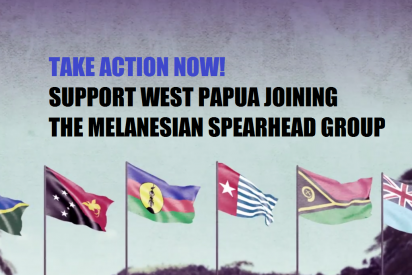Melanesian identity is growing in West Papua, in resistance to the increasing repression of the West Papuan people
October 6, 2016
The beating of tifa drums fills the air. At intervals of the energetic strumming of guitars, a wood flute plays a soft melody and the harmony of Melanesian voices begins to rise; young people in traditional clothes signing a song outlawed in their own land. As the crowd begins to erupt into cries of “Papua Freedom, Papua Freedom” the young musicians emotionally sing
“The only thing I desire and am waiting for, is nothing else but freedom.”
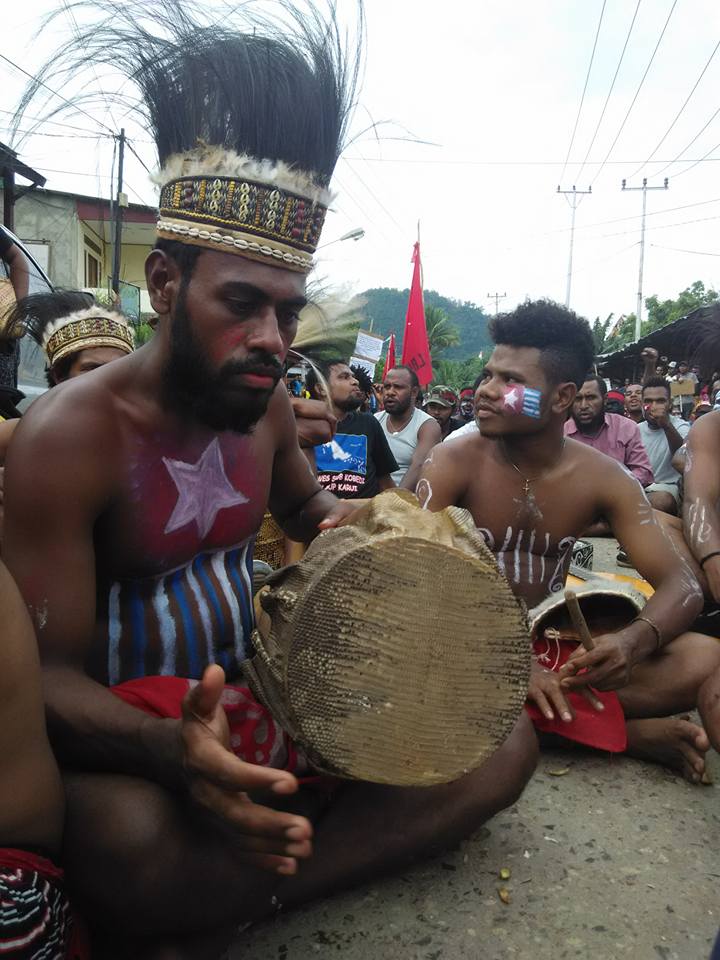
West Papuan youths proudly wearing their traditional Melanesian dress and playing Arnold Ap songs on their kundu drums with their bodies emblazoned with the “outlawed” West Papuan flag. This photo was taken in 2016 at a mass peaceful rally for West Papua’s full membership of the Melanesian Spearhead Group (MSG).
This was the last song composed by West Papua’s most renowned musician, Arnold Ap. At the end of his life he recorded these moving lyrics in his prison cell and soon afterwards was shot dead by the Indonesian Special Forces. Murdered for singing songs.
And yet more than 30 years later, here is the new generation of West Papuan musicians, wearing traditional Melanesian clothes and passionately signing his songs and reviving his spirit; empowering the thousands of other West Papuan people in the call for freedom from oppression.
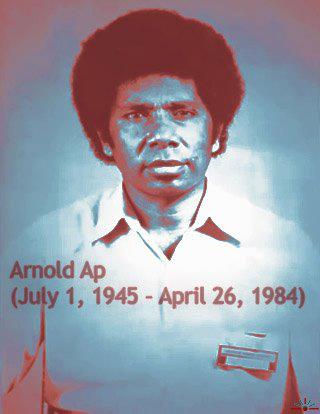
Arnold Ap, a legendary West Papuan musician assassinated by the Indonesian Special Forces simply for singing Melanesian songs.
About West Papua
West Papua is a Melanesian nation that borders Papua New Guinea (PNG) to the East. It shares a totally shared heritage with PNG, with Melanesian environment, people and culture stretching back together for tens of thousands of years without the concept of a border until the arrival of colonialism.
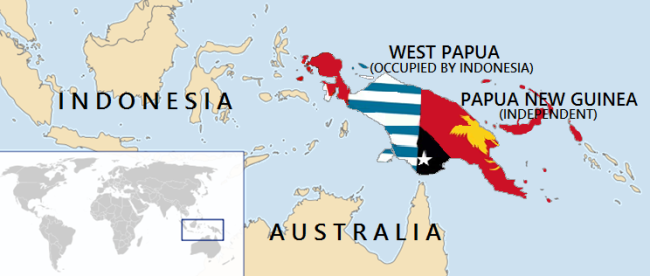
Geopolitical map of West Papua and Papua New Guinea.
For tens of thousands of years, people have crossed all over West Papua and Papua New Guinea; never identifying the modern notion of a political border in the middle of New Guinea. However, when the colonial powers arrived they carved up West Papua and PNG as if cutting a cake. While Papua New Guinea later came under Australian administration and was granted Independence in 1975, West Papua came under Dutch administration and the West Papuan flag was first raised in 1961 with the promise of full Independence 9 years later.
But the government of Indonesia wanted West Papua’s vast reserves of mineral wealth. After the United Nations ruled that Indonesia had no right to take West Papua, Indonesia invaded. This caused a panic and the US government feared that not supporting Indonesia might encourage them to turn to Communism. In 1962 they effectively forced the Dutch government to hand over control of West Papua to Indonesia without the consult of a single West Papuan person. For the sake of Cold War politics, the people of West Papua were sold to a murderous colonial regime.
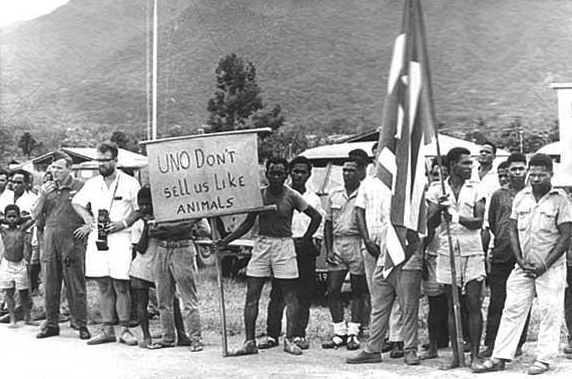
West Papuan people in 1962 calling on the United Nations not to sell them like animals to Indonesia.
The United Nations insisted that there must be an “Act of Free Choice”, an Independence referendum for all the people of West Papua in accordance with their right to self-determination. But the Act was a sham. Claiming that West Papuan people were too “primitive” to cope with democracy, the Indonesian government handpicked just 1,026 people and forced them at gunpoint to vote for Indonesian rule. This clear violation of International Law is now known to West Papuans as the Act of NO Choice.
The Neglected Genocide of West Papua
As soon as the Indonesian government took control of West Papua, they along with the Indonesian military and police began to systematically their systematic ethnic cleansing of the country to try to stamp out resistance. Villages were bombed, people were lined up and shot and women and children were raped and tortured by the Indonesian soldiers.
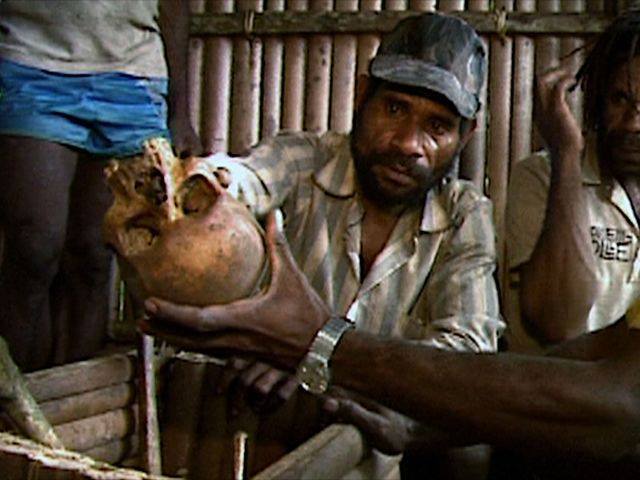
A West Papuan villager shows the skull of a West Papuan person shot dead by the Indonesian military.
It is estimated that ever since Indonesia took control of West Papua over half a million people (nearly a third of the population) have been killed in this Neglected Genocide. The population of West Papua today is totally different from what it would have been if it had not been occupied by Indonesia. In 1970 West Papua and Papua New Guinea both had populations of about 1 million people but PNG’s population is now at 7.3 million while West Papuas’ is only 1.5 million.
Since the first days of the genocide the people of West Papua have resisted Indonesia’s illegal occupation of their country and have been doing all they can to mobilise their people and tell the outside world about their oppression. Until the turn of the 21st Century, many of their cries went unheard because West Papua has been systematically cut off from the outside world by the Indonesian government; banning foreign journalists and trying to stop West Papuan people from ever finding out about their true Melanesian heritage.
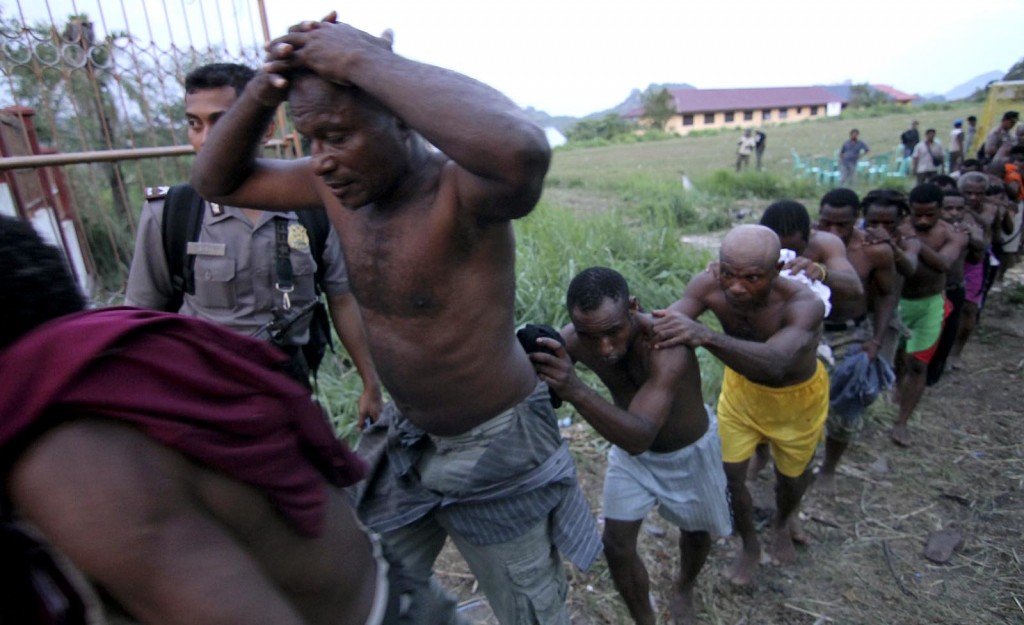
Lined up like slaves and stripped of their clothes, their culture and their dignity. West Papuan people are herded away to be tortured by the Indonesian police after attending a peaceful pro-Independence Congress in 2011.
Cultural suppression in West Papua
The Indonesian government has brutally suppressed not only the people of West Papua but they have also actively sought to try and stamp out Melanesian identity. They even banned the West Papuan flag and West Papuans are now jailed for 15 years just for raising it.
One of the more notorious examples of cultural suppression was known as “Operation Koteka” in the early 1970s which tried to eradicate traditional West Papuan attire, particularly the koteka, the penis gourd traditionally worn throughout the Highlands region of West Papua as well as in some areas of Western Papua New Guinea. In an attempt to stop men from wearing the koteka and women from wearing the traditional grass skirt (sali), the Indonesian government tried to force men to wear shorts and women to wear long skirts made of fabric.
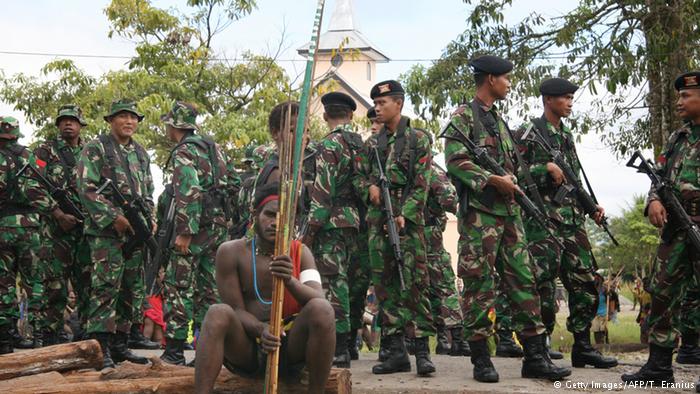
For decades the Indonesian government, military and police have tried all they can to forcibly isolate and eradicate Melanesian culture in West Papua. Photo: Getty Images/AFP/T/ Eranius.
But Melanesian people have lived for tens of thousands of years without wearing Western clothes and such a sudden force of fashion change was bound not to succeed. As a result, women began to use the skirts as extra bilum bags and men began to wear the shorts over their head in a style reminiscent of the traditional hats still worn among many highlands men throughout New Guinea.
However the more fierce revival of Melanesian identity has come about in the last decade and in particular in the last 3 years or so as the now unified West Papuan Independence movement has increasingly focused on reawakening Melanesian solidarity; solidarity the Indonesian government has done so much to try and hide for over 50 years.
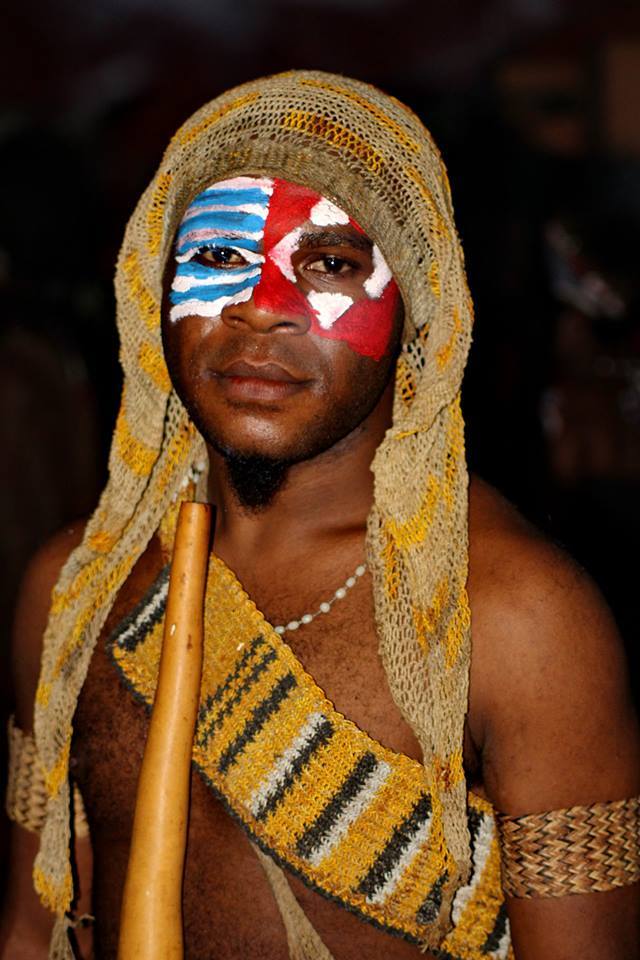
West Papuan student proudly wearing his traditional clothing including a koteka at a Free West Papua cultural event.
For decades, the people of West Papua have been cut off from learning about their true Melanesian culture. At school, they are made to wear the Indonesian national flag as their uniform and only ever see the map of Indonesia rather than seeing the map of West Papua with its connection to PNG.
They have been told by the Indonesian authorities that they are Indonesian, to speak Indonesian and not to speak their Tok Ples (traditional languages). Paradoxically, at the same time they have never been accepted into Indonesian society but have been continually racially abused for being Melanesian; labelled as “stone aged”, “primitive” and “dirty”.
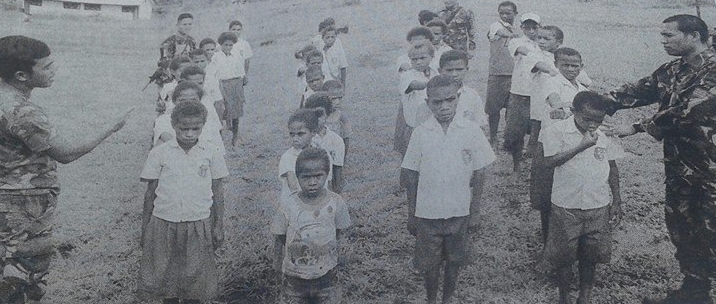
Armed Indonesian military taking the place of teachers and lining West Papuan children up at their Primary School.
This repression of their true cultural identity has meant that West Papuan people in the past have felt culturally isolated, not fitting in anywhere because of not knowing who their fellow Melanesian people are.
Cultural resurgence
However in the last few years the incredible resurgence in Melanesian identity has reinvigorated the new generation of West Papuans, now realizing who they really are and realizing that there are millions of their people sharing a common culture just East of the border, in Papua New Guinea.
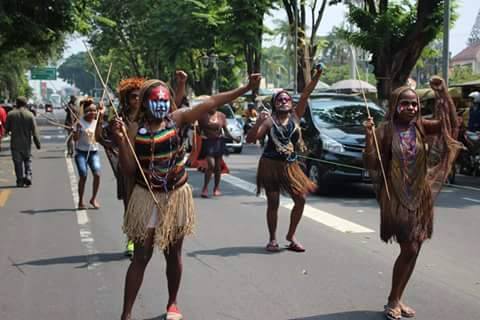
West Papuan students in traditional dress demonstrate for freedom.
It has meant that for the new generation of West Papuans, everything about being Melanesian is cool and the West Papuan youth are becoming increasingly inspired by PNG music, culture and lifestyle. West Papuan youths can now be found wearing PNG/West Papua flag bilums, practicing their Tok Pisin and avidly listening to modern PNG artists such as Anslom Nakkikus and Dadiigii; yearning to be free like their Melanesian brothers and sisters on the other side.
PNG artists and other artists from across Melanesia and the wider Pacific are also finding out about the oppression of their people in West Papua and writing songs of freedom for West Papua is now becoming something that all Pacific artists feel as part of their duty. Musicians everywhere are learning the powerful truth that Music is a Weapon that can fight against oppression.
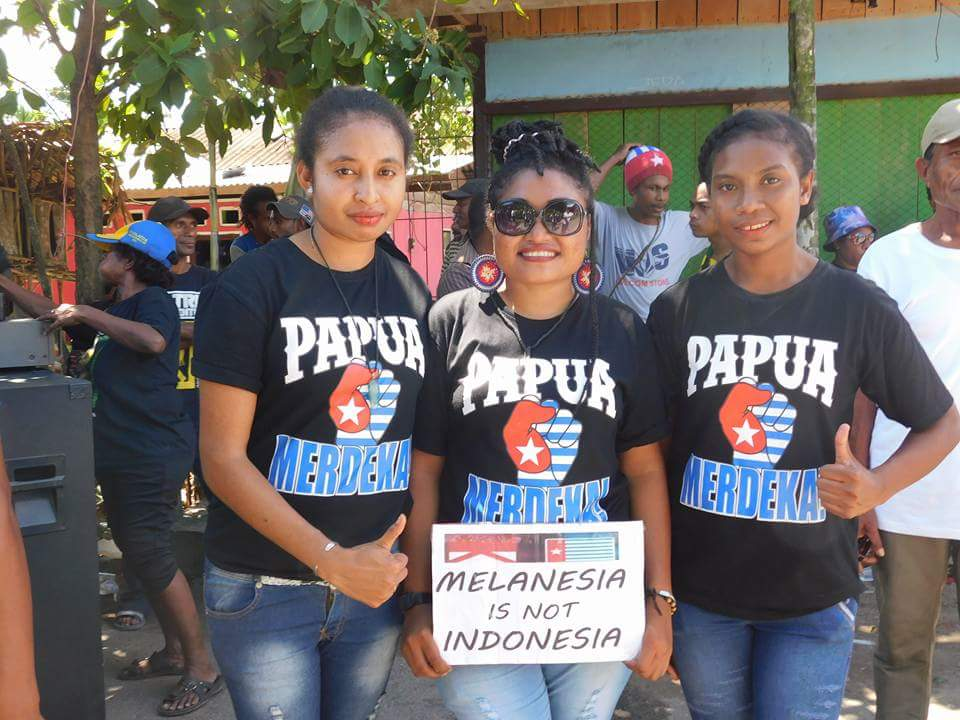
Melanesian youths boldly call for Papua Merdeka (Free West Papua) and proudly assert that Melanesia is NOT Indonesia. Manokwari 2016.
In 2016 West Papuan youths are becoming increasingly proud of who they are and are wholeheartedly embracing their re-found Melanesian culture. This can be seen In the increasing numbers of students who are avidly painting the West Papuan flag on their school uniforms, to the growing number of PNG and Solomon Islands inspired West Papuan reggae songs emerging; using traditional Melanesian styles and singing almost exclusively in their own language or in Tok Pisin rather than in Bahasa Indonesia.
Such a resurgence of traditional Melanesian inspired music is not unlike the growth of Kaneka music in Kanaky/New Caledonia as a means of reaffirming Melanesian identity in the wake of foreign colonialism.
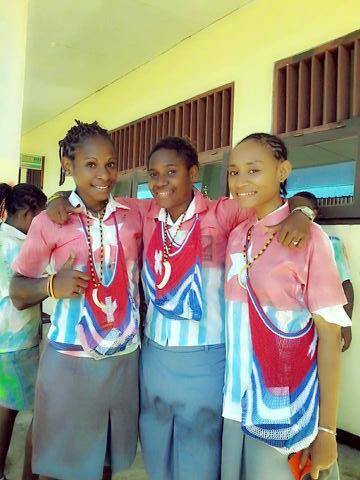
West Papuan students in 2016, their uniforms defiantly painted with the West Papuan flag, displaying their West Papua flag bilums and Melanesian pig tusk necklaces.
Now in even in the capital city of Jayapura, (being increasingly called it’s former name of Port Numbay), West Papuan people are proudly walking down the streets wearing kotekas and salis which would have been considered almost unheard of in the 1970s and 80s.
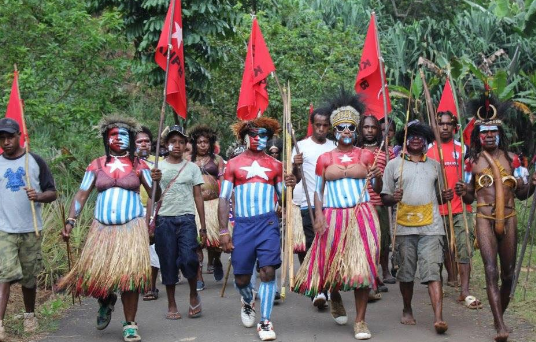
Culture as resistance. West Papuan people in their traditional Melanesian attire marching down the streets to peacefully call for self-determination and Independence.
Melanesian identity as a form of resistance
Unlike in PNG where authorities have generally held a respect for the intrinsic value of traditional culture, in West Papua the Indonesian government has seen anything overtly Melanesian as being a threat to exposing the cultural reality that West Papua is not Indonesian. In the past many West Papuan dance costumes were made using more silk like Asian attire, often wearing the red and white colours of the Indonesian flag.
An example of extreme cultural repression was what happened in the village of Waghete in 2013 when the Indonesian police went around confiscating people’s phones that had songs from West Papua or PNG on. They then took scissors and demanded that West Papuan people with beards or dreadlocks cut their natural hair. A West Papuan boy, Alpius Mote refused and just for refusing to shave his Melanesian hair he was shot dead. Therefore reasserting Melanesian identity is a truly powerful and truly brave act of resistance in West Papua.
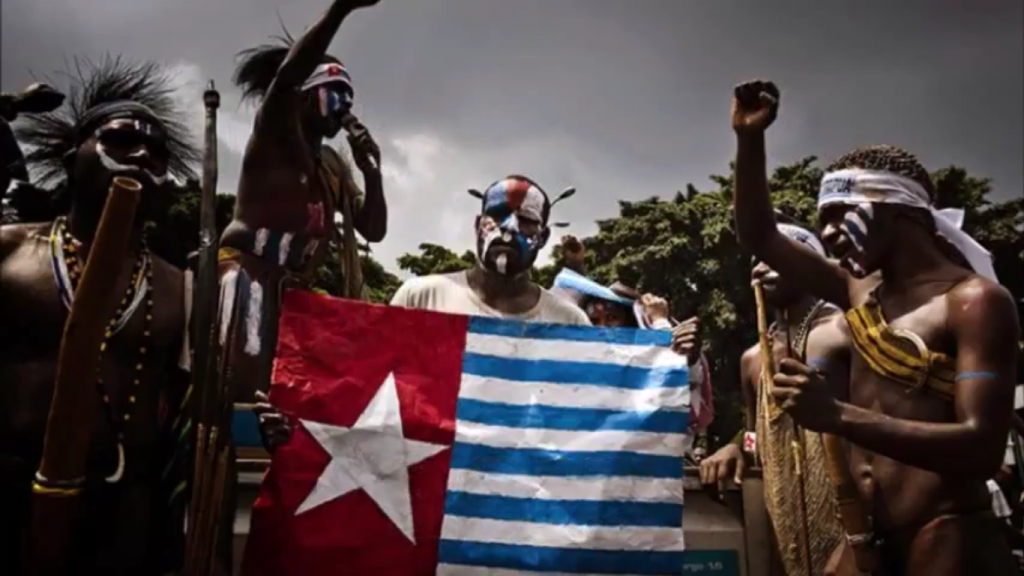
West Papuan youths defiantly raising the West Papuan flag and wearing their traditional Melanesian attire at a Free West Papua demonstration.
The youth of West Papua are now refuting the “Indonesianized” plastic version of their culture and are wearing Melanesian hairstyles with pride, actively learning how to make traditional bilum bags, grass skirts and headdresses and confidently playing their kundus and garamuts (traditional Melanesian drums). With the widespread use of social media, West Papuan youths are becoming proud to share their cultural revival and freedom struggle with the world as West Papua becomes awash with traditional Melanesian culture with a modern, patriotic twist. In 2016 young West Papuans proudly wear kotekas and salis and boldly take selfies of themselves with the West Papuan flag painted on their face.
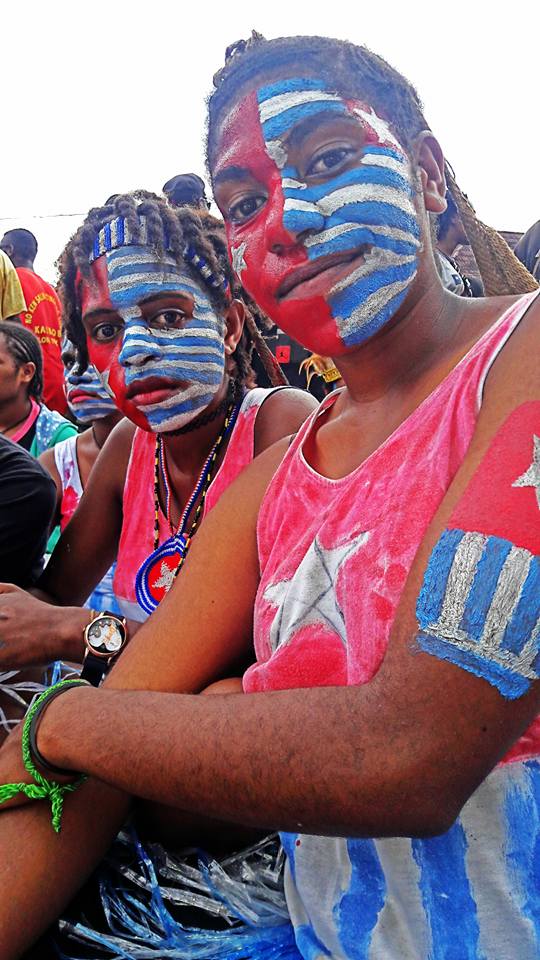
West Papuan youths taking selfies in Port Numbay/Jayapura at a mass rally calling for West Papua’s full membership of the Melanesian Spearhead Group (MSG). June 2016.
Melanesian identity growing from repression
It could be argued that traditional Melanesian culture in PNG is changing and adapting, perhaps in certain cases even disappearing as a result of the fast changing influences of globalization in the country. However, fighting to keep Melanesian culture alive is all the more desperate in West Papua because doing so is helping to ensure the very survival of the West Papuan people.
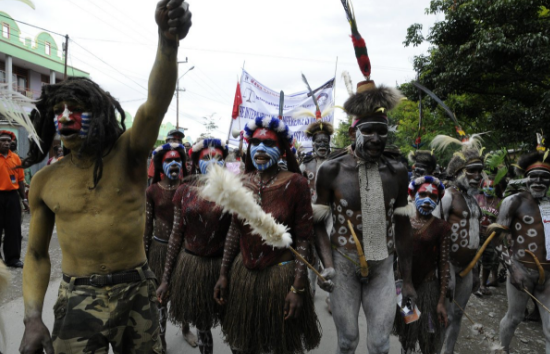
Proudly Melanesian not Indonesian. West Papuan people in Wamena rally to call for freedom from Indonesian colonialism.
In a struggle for freedom and Independence, cultural identity is one of the most crucial factors and the cultural resurgence now sweeping across West Papua is testimony to the growing Melanesian identity among West Papuan people, displayed as a means of resisting repression of both people and culture.
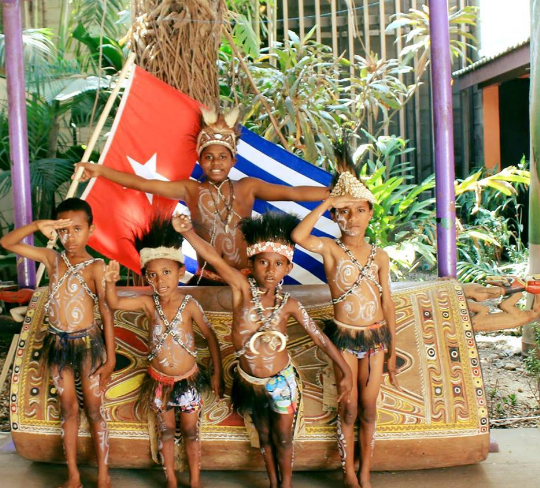
West Papuan boys in traditional dress, saluting in front of their national flag and a garamut drum.
As Victor Yeimo, the Chairperson of the West Papua National Committee (KNPB) once famously said
“I must thank the colonialists for continuously teaching us to aspire to true humanity by means of rebellion.”
It is an incredible irony for the Indonesian government that despite over 50 years of colonial occupation, the influx of millions of Indonesian “transmigrants” and the systematic cultural repression of the West Papuan people; West Papuan cultural identity only continues to grow stronger and with it the struggle for freedom and Independence from Indonesian colonialism.
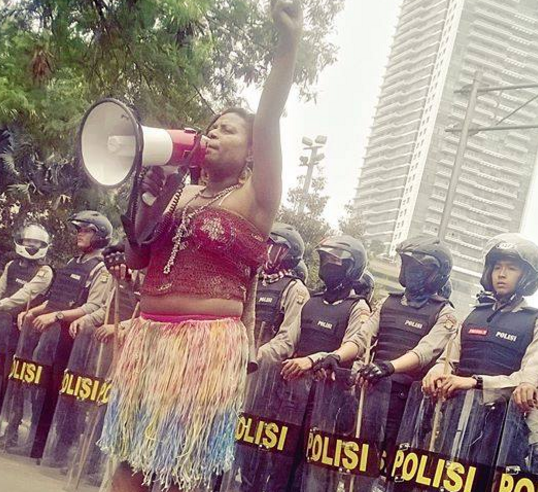
A powerful show of resistance and defiance of Indonesian oppression, a West Papuan student in traditional dress rallies her people in a freedom salute at a peaceful demonstration in December 2015.
Melanesian Consciousness and The Pan-Melanesian Movement
This Melanesian Consciousness movement has massively been driven forward by the extraordinary efforts of West Papuan people and people across Melanesia to support West Papua’s full membership of the Melanesian Spearhead Group (MSG). Highly effective campaigning by the United Liberation Movement for West Papua (ULMWP) has led to mass awareness about Melanesian Unity as a means of stopping the genocide of Melanesian people in West Papua.
The people of West Papua are literally raising the flags of their fellow Melanesian nations and showing their wantoks that they are risking their very lives to call for help and Melanesian solidarity.
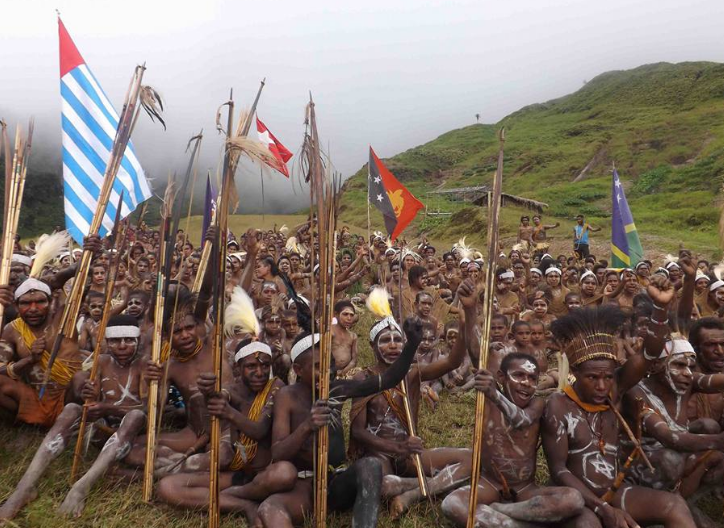
West Papuan people in the Star Mountains region on the border with Papua New Guinea raise Melanesian flags and call for support for West Papua’s full membership of the Melanesian Spearhead Group (MSG).
All across Melanesia, it has therefore become an issue of utmost importance to bring West Papua back into it’s rightful place in the Melanesian family as a full member of the MSG. In West Papua, PNG, Solomon Islands, Vanuatu, Kanaky/New Caleonia and Fiji people are coming together and saying in one united voice: BRING WEST PAPUA BACK TO THE FAMILY.
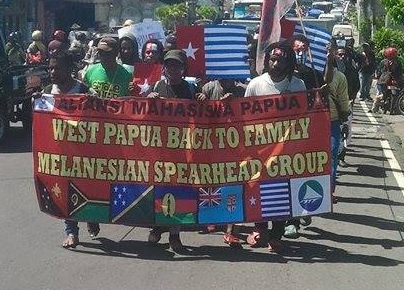
West Papuan students marching to call for West Papua’s return to the Melanesian family as a full member of the Melanesian Spearhead Group (MSG).
This renewed importance on Melanesian and indeed wider Pacific Island solidarity is certainly having an enormous impact throughout the region. If you had asked anyone in Melanesia in the 1970s, they were unlikely to have known about West Papua and perhaps more likely to know it by it’s former colonial Indonesian name of “Irian Jaya”. Ask anyone in 2016 and they are much more likely to know about the real and terrible situation in West Papua, express their sadness at the suffering of their people, and express their determination to help West Papua to be free.
There are so many people across Melanesia and the Pacific who are now finding out about the secret genocide and illegal occupation suffered by their brothers and sisters in West Papua. As fellow Pacific Islanders, hearing of such oppression of their people reaches into their hearts and is moving them to stand up and spread the word in support of West Papua’s freedom.
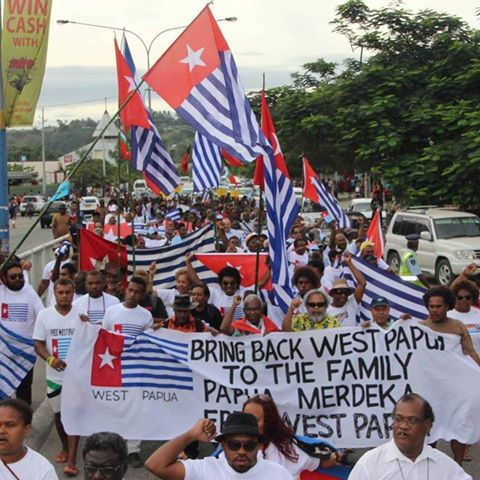
Mass Free West Papua rally in Honiara, Solomon Islands 2015, calling to bring back West Papua to the family as a full member of the Melanesian Spearhead Group (MSG).
As a result of these incredible shows of people power including mass rallies in every Melanesian nation; civil societies and governments from across the Pacific are standing up to support the fundamental rights of their fellow Pacific Islanders in West Papua. Only last month, no less than 7 Pacific Island nations made speeches at the United Nations General Assembly supporting the people of West Papua and their fundamental rights, marking an incredibly historic turning point in the West Papuan people’s long struggle for self-determination and freedom.
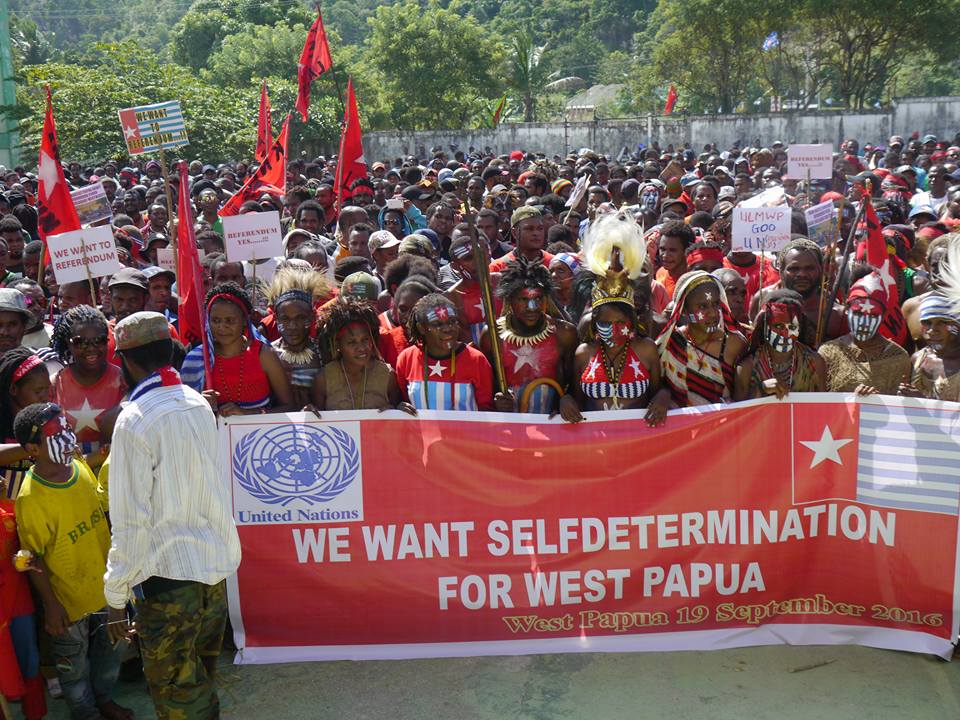
West Papuan people gather in Port Numbay/Jayapura to call for self-determination and to thank the increasing number of Pacific Island nations which are supporting them.
Impact on the rest of Melanesia and the Pacific
In fact it could be argued that not only is Melanesian identity having a resurgence in West Papua but that this resurgence is fueling the wider Pan-Melanesian Consciousness movement across Melanesia, inspiring Melanesian people to come together as One People, One Soul and to struggle together against injustice and exploitation. The Tok Pisin expression Wansolwara (One Ocean) is now being used across Melanesia and even the rest of the Pacific as a rallying call to unite people together in the spirit of compassion and solidarity.
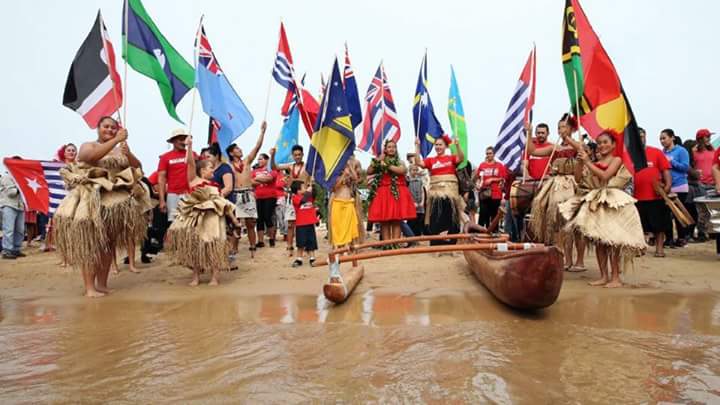
West Papuan flags joining other Pacific Islands nation flags at a recent rally of Pacific solidarity against Climate Change.
Hope in Melanesian identity
A sense of identity is so important to us all as human beings as having confidence in your culture is crucial for a lifestyle where we can feel proud and happy, knowing for certain exactly who we are.
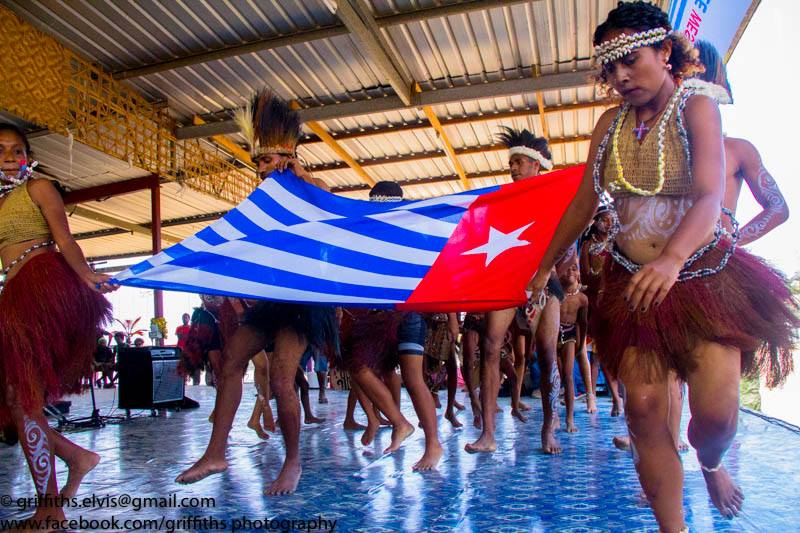
West Papuan youths dancing in their traditional bilas (traditional dress) at a West Papuan Cultural Day in Port Moresby, Papua New Guinea. Photo: Elvis Griffiths.
Ultimately, this growing sense of Pan-Melanesian Consciousness and identity marks a new hopeful era beginning to sweep through West Papua and across Melanesia; one in which Melanesian solidarity is paramount and maintaining Melanesian culture and values is not just a political statement but a profoundly essential part of modern life and community.
It is the growing hope of the people of West Papua, as well as people throughout Melanesia, the wider Pacific and indeed around the world that West Papuan will one day be able to live in their own free ancestral Melanesian land once again; freely embracing their culture and being proud to be Melanesian people.
